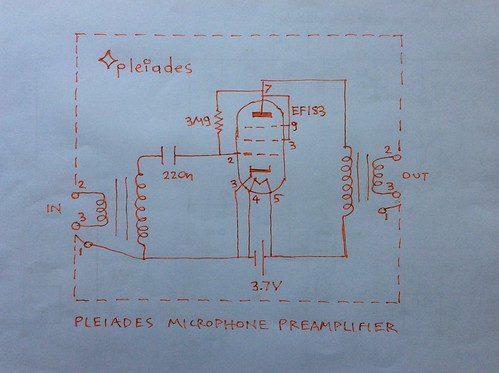Serial number (date time code) is 18062416.
It reduces bass at a slope smaller than 6dB per octave in an attempt to compensate for Fletcher Munson, voice effort curves with the minimum number of components, simplest signal path. The attempt is really flat frequency response from producer's brain to listener's brain. Some nice sounding and natural L, R values with no bass heaviness were found by singing to the magnificent Sennheiser MD211 N connected to the Pleiadss V6 one electron tube head amplifier. The input transformer used in the Pleiades V6 for these experiments is the Altec 4722. See relevant posts.
The values of 40mH and 140Ω were chosen.
The resistor is in series with the inductor. The total is connected in parallel to the voice coil (or amplifier input).
In order to make it completely symmetrical it was made as 70Ω 40mH 70mH.
A total of twenty 680Ω very small carbon resistors were measured until 2 were found with the values of 70Ω. So 2 matched 70Ω resistor were used.
Neutrik cylindrical XLR modules were used so that the end result is beautiful and of great quality. The centre stripe gap was filled with blue nail paint-varnish. (Annie Paris no 245). The stripe is made as best as possible by protecting the hills that are not to be pained by scotch opaque tape. The tapes are removed as soon as possible after applying the paint.
So it looks like a very beautiful Neutrik XLR female to male adaptor with a blue centre stripe.
How is it made?
The schematic is as follows:
Starting from input, pin 2 is connected to one side of 70Ω the other side to 40mH, the other side of 40mH to the other 70Ω resistor and the other side of this resistor to pin 3. At the same time a twisted pair thin single core cable connects pin 2 of input XLR to pin 2 of output XLR. Same for pins 3. So the mic signal goes straight through. It is only the nasty bass that we do not want that the filter removes being a subtractive passive filter.
No make up gain is needed. For a great signal to noise ratio a Pleiades V6 mic booster electron tube head amp can be used after the mic and filter. The output will be a healthy strong signal. The following preamp can be set at low gain so that it's hiss is reduced.
Pin 1 ie Xternal is connected to the metal part of the Neutrik connectors following the great advice from the Jensen transformers website, as we would do when building a preamp with XLR connector sockets to avoid pin 1 problems.
Opaque thermal sleeves are rolled inside the resistors and used to protect from short circuits of their end terminals.
So far the Pleiades mic filter has been tested will an inductance meter. Although the resistors are in the circuit, the meter still shows 40mH.
(Later same day addition)
How does it sound.
Unfortunately it sounds nice but as good as the experimental on with wires sticking out all over the place.
The one with 2 different inductors in parallel and 1 resistor all vonnected with aligator cable clips sound more bandwidth extended, less peaky etc. 2 different cores are used one Siemens ferrite and the other Magnetec Nanoperm.
Later on an obvious difference measured is higher series resistance on the experimental Pleiades filter. More on a latter post with title Why the Pleiades filter 70ohm,40mH,70ohm does not sound as good as expected?
References:
Flat frequency response from producer's brain to listener's brain, Sound Picture Recording and Reproducing Characteristics - D. P. Lowe, K. F. Morgan - JSMPE
Pleiades V6 schematic (with 22nF, 6MΩ Pleiades bias resistor, EF183 or Nuvistor 7586)

No comments:
Post a Comment